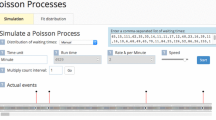Abstract
The primary aim of the present article is to provide a general framework for investigating the joint distribution of run length accumulating/enumerating variables by the aid of a Markov chain embedding technique. To achieve that we introduce first a class of bivariate discrete random variables whose joint distribution can be described by the aid of a Markov chain and develop formulae for their joint probability mass function, generating functions and moments. The results are then exploited for the derivation of the distribution of a bivariate run-related statistic. Finally, some interesting uses of our results in reliability theory and educational psychology are highlighted.
Similar content being viewed by others
References
Agin M.A., Godbole A.P. (1992). A new exact runs test for randomness. In: Page C., Le Page R. (eds) Computing science and statistics, Proceedings of the 22 symposium on the interface (pp. 281–285). Berlin Heidelberg New York: Springer.
Aki S., Hirano K. (1988). Some characteristics of the binomial distribution of order k and related distributions. In: Matusita K. (eds) Statistical theory and data analysis II. Elsevier Science, North-Holland, pp. 211–222.
Antzoulakos D.L., Chadjicostantinides S. (2001). Distributions of numbers of success runs of fixed length in Markov dependent trials. Annals of the Institute of Statistical Mathematics 53:579–619.
Antzoulakos D.L., Bersimis S., Koutras M.V. (2003). On the distribution of the total number of run lengths. Annals of the Institute of Statistical Mathematics 55(4):865–884.
Balakrishnan N., Koutras M.V. (2002). Runs and scans with applications. Wiley, New York.
Chao M.T., Fu J.C., Koutras M.V. (1995). A survey of the reliability studies of consecutive-k-out-of-n: F systems and its related systems. IEEE Transactions on Reliability 44:120–127.
Doi M., Yamamoto E. (1998). On the joint distribution of runs in a sequence of multi-state trials. Statistics and Probability Letters 39:133–141.
Feller W. (1968). An introduction to probability theory and its applications (Vol I 3rd edn). Wiley, New York.
Fu J.C. (1996). Distribution theory of runs and patterns associated with a sequence of multistate trials. Statistica Sinica 6:957–974.
Fu J.C., Koutras M.V. (1994). Distribution theory of runs: a Markov chain approach. Journal of the American Statistical Association 89:1050–1058.
Fu J.C., Lou W.Y.W. (2003). Distribution Theory of Runs and Patterns and Its Application. World Scientific, Singapore.
Gani, J. (2003). Patterns in sequences of random events. In D.N. Shanbhag, C.R. Rao (Eds.) Handbook of Statistics, (Vol. 21, pp. 227–242).
Glaz J., Naus J., Wallenstein S. (2001). Scan statistics. Springer, New York.
Grant D. (1946). New statistical criteria for learning and problem solution in experiments involving repeated trials. Psychological Bulletin 43:272–282.
Guibas L.J., Odlyzko A.M. (1981). String overlaps, pattern matching and nontransitive games. Journal of Combinatorial Theory, Series A 30:183–208.
Han Q., Aki S. (1999). Joint distributions of runs in a sequence of multistate trials. Annals of the Institute of Statistical Mathematics 51:419–447.
Koutras M.V. (1997). Waiting time distributions associated with runs of fixed length in two-state Markov chains. Annals of the Institute of Statistical Mathematics 49:123–139.
Koutras, M.V. (2003). Applications of Markov chains to the distribution theory of runs and patterns. In D.N. Shanbhag, C.R. Rao(Eds.), Handbook of statistics, (Vol. 21, pp. 431–472).
Koutras M.V., Alexandrou V.A. (1995). Runs, scans and urn model distributions: A unified Markov chain approach. Annals of the Institute of Statistical Mathematics 47:743–766.
Leslie R.T. (1967). Recurrent composite events. Journal of Applied Probability 4:34–61.
Lou W.Y.W. (2003). The exact distribution of the k-tuple statistic for sequence homology. Statistics and Probability Letters 61:51–59.
Mood A.M. (1940). The distribution theory of runs. Annals of Mathematical Statistics 11:367–392.
O’Brien P.C., Dyck P.J. (1985). A runs test based on run lengths. Biometrics 41:237–244.
Rajarshi M.B. (1974). Success runs in a two-state Markov chain. Journal of Applied Probability 11:190–192.
Author information
Authors and Affiliations
Corresponding author
Additional information
Research supported by General Secretary of Research and Technology of Greece under grand PENED 2001.
About this article
Cite this article
Koutras, M.V., Bersimis, S. & Antzoulakos, D.L. Bivariate Markov chain embeddable variables of polynomial type. AISM 60, 173–191 (2008). https://doi.org/10.1007/s10463-006-0080-6
Received:
Revised:
Published:
Issue Date:
DOI: https://doi.org/10.1007/s10463-006-0080-6




